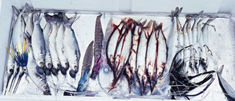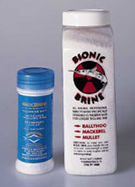Would you eat a steak if it smelled funky or looked a little green? Probably not, and many offshore trollers believe that's the same way a tuna or billfish feels about consuming a bait that looks or smells a bit "unnatural." That's what drives these anglers in their quest for the freshest bait possible.
Whether it's ballyhoo, mullet, mackerel, squid or belly strips, the pros know that the appearance, scent and taste of a properly rigged natural bait is the key that ultimately coaxes a game fish into eating. Sure, average-quality baits will work when fish are numerous and hungry. But over the long haul, the freshest baits will yield the most consistent results. There's simply no shortcut.
It's the Brine, Baby
Many anglers don't realize that even the freshest bait tends to wash out quickly if it isn't brined properly. Before I located a good source of fresh, blast-frozen baits, which I now stock in my bait freezer, I would either purchase fresh ballyhoo the day they arrived at my South Florida bait wholesaler or catch them myself off the Upper Keys. I would immediately soak the baits in a mixture of salt water, Kosher salt and ice, and either rig them later that evening or the next day. After each bait was rigged and rinsed in salt water, it was placed in a cooler between layers of cubed ice. Both ice and baits were liberally dusted with Kosher salt and a sprinkling of baking soda, with leaders "sandwiched" between empty ice bags to prevent them from sticking to the ice. As the ice melted, diluting the salt and baking soda, a near-freezing brine was created that further preserved and toughened the baits. The "slushy" brine was maintained by adding ice and salt as necessary and periodically draining the cooler.
|
On the day of the fishing trip, a half-dozen baits would be removed from the cooler on the way to the grounds and completely thawed in a bucket of sea water. Before deployment, I would bend each bait back and forth several times to make it more flexible. As long as the consistency and near-freezing temperature of the brine was maintained, our baits remained in prime shape for nearly a week.
Salt and Soda, Please
Ice aside, two essential ingredients for creating an effective brine include a coarse salt (eg., Kosher or Solar salt) and baking soda, with the exact amount of each ingredient hinging on how tough you want your baits to be. Go heavy on the salt and the baits become overly dry and rigid, diminishing their action. Too light and the baits could wash out prematurely or tear free from the hook on a strike.
The salt is primarily what toughens the bait. It also thwarts bacterial growth, preserving the quality of the bait's flesh. The baking soda (sodium bicarbonate) is chiefly responsible for retarding enzyme breakdown, helping to maintain the bait's coloration and fresh scent. It also helps toughen the bait, but to a lesser extent than salt.
According to Mark Pumo of BAITMASTERS of South Florida, a major distributor of rigged and unrigged natural baits, a coarse-grade salt makes a concentrated formula that maintains a slushy, near-freezing brine. "It's also responsible for drawing out moisture in the bait," explains Pumo. When a non-brined bait is frozen, the moisture freezes and causes the meat to expand. This often causes the flesh to separate and tear. When thawed, the bait is mushy.
 "Baking soda is also very important," adds Mark. "I've been in the bait business for nine years and had plenty of trial-and-error experience with different brine batches and formulas. If you don't add baking soda to the brine, the bait tends to get a little softer and its skin will tear a little easier."
"Baking soda is also very important," adds Mark. "I've been in the bait business for nine years and had plenty of trial-and-error experience with different brine batches and formulas. If you don't add baking soda to the brine, the bait tends to get a little softer and its skin will tear a little easier."
Pat Lynch of Bionic Bait echoes Pumo's opinions. "When we catch our bait, we treat it better than we do the sushi tuna, groupers and snappers caught aboard our fishing boat," says Lynch. "Properly brining baits right after their capture is critical, and ours go right into a special wet brine. I prefer using a fine salt, which dilutes much more rapidly in water and is absorbed more thoroughly by the baits. The salt basically helps draw out moisture and toughen the bait, while the baking soda preserves its color. This is especially true with a dry brine. In fact, our Bionic Brine came about because so many people wanted to buy the exact brine formula we use commercially."
Secret Formulas?
BAITMASTERS is a premier distributor of premium-quality trolling baits such as flying fish, ballyhoo, mackerel, mullet and squid, as well as chum and various other salt water baits and rigging materials. Bionic Bait is the largest rigged-bait producer in the country, as well as a major supplier of menhaden chum and numerous small salt water baitfish, including sardines, threadfin herring, glass minnows and silversides. Both companies are now marketing their own brand of brining powder that expedites and simplifies the proper brining of virtually any natural bait. Their formulas are seeing widespread use on the world's most productive offshore waters, and can be found in many tackle centers and marinas.
BAITMASTERS's MagicBrine powder is a mixture of coarse-grade salt, baking soda and a proprietary additive'’’the same formula the company uses for wet-brining its baits prior to blast-freezing. MagicBrine is available in an eight-ounce plastic shaker bottle that conveniently fits inside a tackle box, or a five-pound bag. Retail prices run around $2 per bottle and $5 per bag.
Bionic Bait's Bionic Brine comes in a three-pound, watertight jug that sells for around $5. The powder is also available in "special request" 25-pound pails. The Bionic Brine powder consists of fine Solar salt, baking soda and several secret additives.
How to Use Them
According to Mark Pumo, a wet brine is recommended only for freshly caught bait. Packaged, frozen baits, providing they're from a reputable source, have already been brined and processed. Therefore, it's best to treat them with a dry brine.
When creating a wet brine, Pumo says to use one eight-ounce bottle of MagicBrine per gallon of water, then add crushed or cubed ice to create a slushy mixture. This will make a shallow brine for approximately three dozen medium ballyhoo. The five-pound bag is designed to brine a 94-quart cooler of bait.

Whether it's ballyhoo, mullet, mackerel, squid or belly strips, the pros know that the appearance, scent and taste of a properly rigged natural bait is the key that ultimately coaxes a game fish into eating.

"When dry-brining, it's best to let the processed baits thaw out in their bags first," says Pumo. "The baits should then be rigged, rinsed in salt water and arranged belly-up in a bait cooler. Sprinkle the MagicBrine on their bellies and let them sit for a minimum of four hours. As the brine works on the bellies, it will actually draw out moisture. Soon the entire bait will be coated with the solution because it will settle inside the bait, as well as over their sides and onto their backs. The belly is the most important area to initially brine because it's the softest part of the bait and where the stomach contents are located. Also, if you arranged the baits on their sides, you couldn't fit as many in a cooler, let alone dry-brine them properly." Pumo advises keeping dry-brined baits away from ice and water by arranging them on a sheet of aluminum foil or on a bait tray. The cooler's drain should remain open.
Pat Lynch recommends using his Bionic Brine in a similar fashion when dry-brining. As for the amount to use, Lynch says that it depends on the quality of the bait. "If you get soft baits, you can go heavy on the brine powder and toughen them up. I've had numerous calls from mates who were fishing off Mexico, Venezuela and other remote destinations who claimed my Bionic Brine saved their trips because it toughened up baits of marginal quality. Take a small ballyhoo, for example, which is a great white marlin bait. If it's soft, it may last only minutes. After some moderate dry-brining, however, the bait may be able to withstand a couple hours of trolling."
Lynch recommends dry-brining quality baits with a moderate dusting of Bionic Brine. Do not overbrine by completely covering the baits. He recommends arranging the baits belly up on a sheet of aluminum foil placed over ice, or in the aluminum trays of a Baiter's Box cooler. Several small holes should be poked in the aluminum foil to drain any residue. Sprinkle Bionic Brine on the baits and let them sit for several hours. Properly dry-brined baits may last for three to four days on a sheet of foil or a cold tray. When dry-brining, the cooler drain should be left open to prevent water accumulation.
While rigging natural baits remains an art, the brining part of the game just got a lot simpler. Thanks to the convenience provided by the new brining powders, there's no more headaches over acquiring and mixing the right ingredients. If this stuff is good enough for two major bait suppliers and numerous big-game anglers worldwide, just think how it will keep your baits looking and performing their very best.
|
|||


 MagicBrine and Bionic Brine are available at many tackle shops and marinas. To find the nearest local dealer, or for information on the companies' lines of natural baits, contact:
MagicBrine and Bionic Brine are available at many tackle shops and marinas. To find the nearest local dealer, or for information on the companies' lines of natural baits, contact: